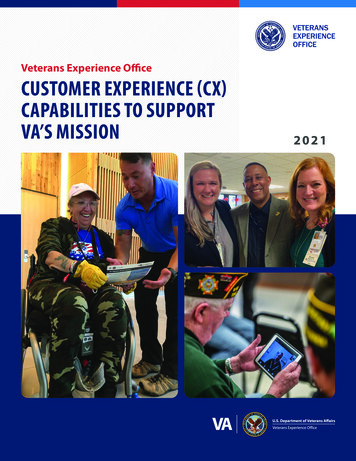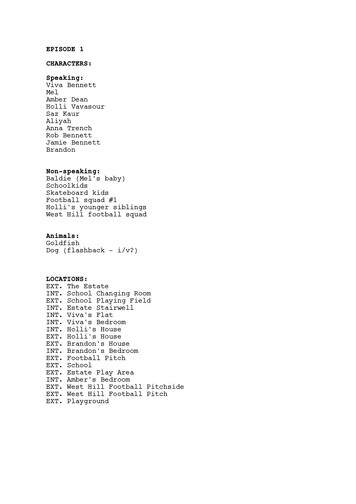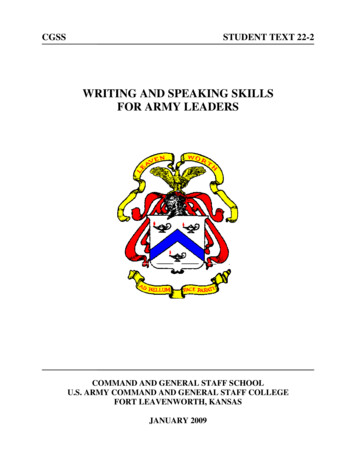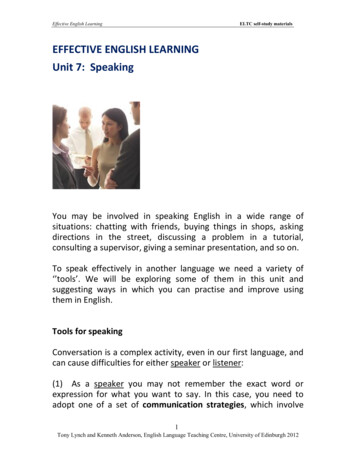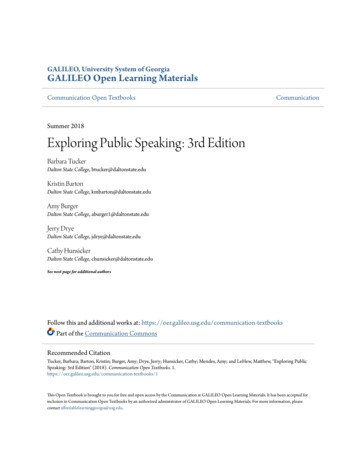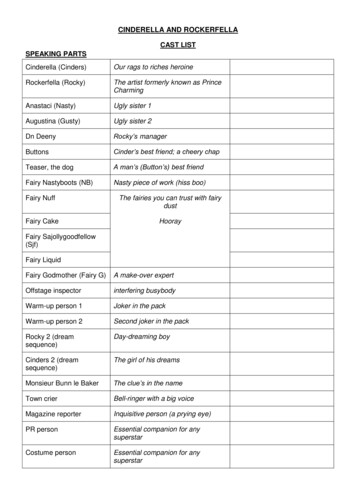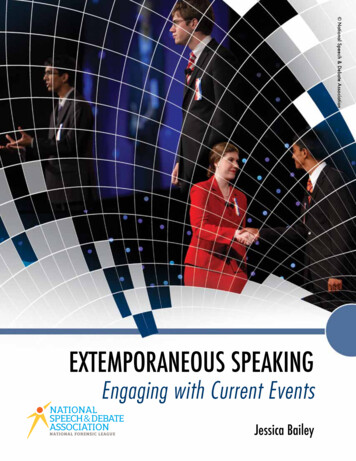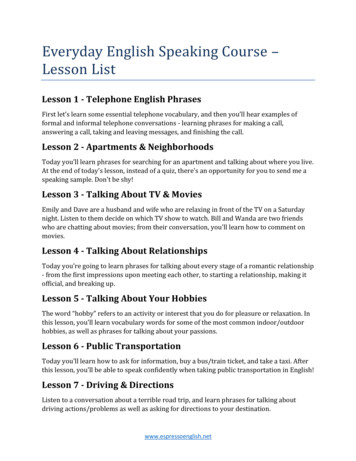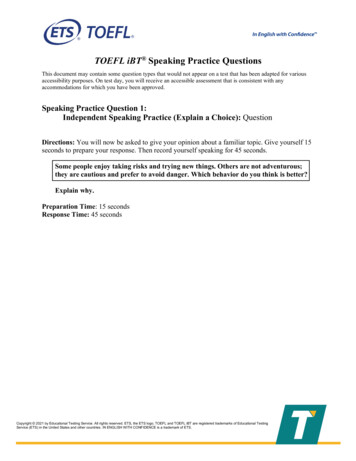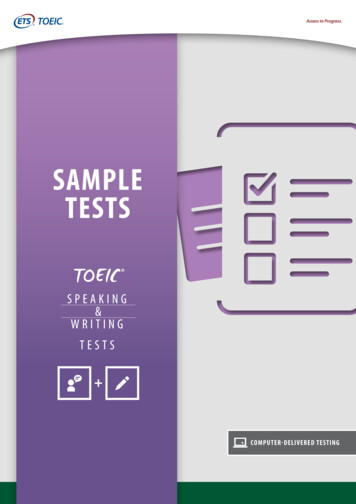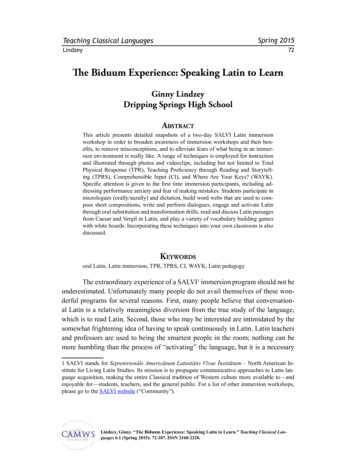
Transcription
Spring 2015Teaching Classical LanguagesLindzey72The Biduum Experience: Speaking Latin to LearnGinny LindzeyDripping Springs High SchoolAbstractThis article presents detailed snapshots of a two-day SALVI Latin immersionworkshop in order to broaden awareness of immersion workshops and their benefits, to remove misconceptions, and to alleviate fears of what being in an immersion environment is really like. A range of techniques is employed for instructionand illustrated through photos and videoclips, including but not limited to TotalPhysical Response (TPR), Teaching Proficiency through Reading and Storytelling (TPRS), Comprehensible Input (CI), and Where Are Your Keys? (WAYK).Specific attention is given to the first time immersion participants, including addressing performance anxiety and fear of making mistakes. Students participate inmicrologues (orally/aurally) and dictation, build word webs that are used to compose short compositions, write and perform dialogues, engage and activate Latinthrough oral substitution and transformation drills, read and discuss Latin passagesfrom Caesar and Vergil in Latin, and play a variety of vocabulary building gameswith white boards. Incorporating these techniques into your own classroom is alsodiscussed.Keywordsoral Latin, Latin immersion, TPR, TPRS, CI, WAYK, Latin pedagogyThe extraordinary experience of a SALVI1 immersion program should not beunderestimated. Unfortunately many people do not avail themselves of these wonderful programs for several reasons. First, many people believe that conversational Latin is a relatively meaningless diversion from the true study of the language,which is to read Latin. Second, those who may be interested are intimidated by thesomewhat frightening idea of having to speak continuously in Latin. Latin teachersand professors are used to being the smartest people in the room; nothing can bemore humbling than the process of “activating” the language, but it is a necessary1 SALVI stands for Septentrionāle Americānum Latinitātis Vīvae Īnstitūtum – North American Institute for Living Latin Studies. Its mission is to propagate communicative approaches to Latin language acquisition, making the entire Classical tradition of Western culture more available to—andenjoyable for—students, teachers, and the general public. For a list of other immersion workshops,please go to the SALVI website (“Community”).Lindzey, Ginny. “The Biduum Experience: Speaking Latin to Learn.” Teaching Classical Languages 6.1 (Spring 2015): 72-107. ISSN 2160-2220.
Teaching Classical LanguagesLindzeySpring 201573step in developing true fluency with the language, including reading fluency. Third,even those who can imagine the fun of immersing oneself in speaking Latin can beskeptical about the practical benefits for themselves and their classrooms. However,if our goal as teachers and students is to read Latin fluently, then finding ways todevelop that fluency is our utmost concern (see Rasmussen).In the summer of 2013, I served as a repetītor (assistant) at a Biduum atAustin College in Sherman, Texas2. For the four previous summers I had attendedRusticātiō Virginiāna as a participant, and I have gradually begun to work some ofthese techniques into my own classes. Thus I have an understanding of what it islike being a participant as well as being an assistant, plus some of the challenges andthe excitement of incorporating what I have learned into my own classroom. In thispaper, I will describe and demonstrate via photos and video clips what takes place atone of SALVI’s immersion programs, and how these activities tie into what we cancarry back to our own classrooms, not to mention to our own lives.The following topics do not follow the order in which participants experienced them. After explaining how the immersion process begins, I have tried to sortand group activities according to pedagogical innovations that are far from what istypical of a traditional Latin class, with emphasis on different ways to approach passages of Latin text besides simply translating into English. Reinforcement activitiesand review games which consolidate learning then follow. Many of the approachesand activities are based on the Rassias Method, TPR (Total Physical Response),TPRS (Teaching Proficiency through Reading and Storytelling), CI (Comprehensible Input) and the works of Stephen Krashen, and WAYK (Where Are Your Keys?),a language hunting system developed by Evan Gardner (see Appendix 1 for furtherexplanation of each approach).2 I want to offer a very special thanks to Austin College in Sherman, Texas, and the RichardsonSummer Language Institute for hosting this first Texas Biduum. The Richardson Summer LanguageInstitute has been very generous to Texas foreign language teachers over the years and this was aparticularly wonderful event. The ability to use the Jordan Family Language House (we occupiedthe Japanese corner which included dorm rooms and a commons room, plus we had access to a fullkitchen and computer labs) allowed us to be isolated from those speaking English on the rest ofthe Austin College campus, thus allowing us to have our immersion experience. The participants,most of whom are pictured throughout this paper, included Deborah Baptiste, Philip Bennett, SarahBuhidma, Suzanne DePedro, Frank Kelland, Emmie Osburn, Michala Perreault, Shelly Sable, andKenneth Toliver. Also present were Jim Johnson, Professor Emeritus, Austin College, and our host,Bob Cape, Professor of Classics & Director of the Center for Liberal Arts Teaching and Scholarship,Austin College.
Teaching Classical LanguagesLindzeySpring 201574How We BeginIdeally, to benefit from an immersion experience, students need to be totallyengaged in the activities involving them, not taking notes. Of course, as teachers, weare keen to take notes so that we don’t forget any aspect of what we are learning. Forthis reason, while the magistra3 instructs and engages the participants from the frontof the room, a repetītor is placed somewhere to the side with a large paper easel andmarkers in order to write down virtually everything the magistra is saying in Latin.If explanations or definitions are needed, they are also written in Latin or illustratedwith pictures. (There is no English!) Once a sheet is filled, it is posted on the wallfor all to see. Some pages will have odd inclusions that come from side discussionsabout weather or other tangential topics. During breaks, participants can either copydown notes or take pictures of these sheets for their own use.The magistra begins by announcing and discussing three basic principlesthat create a framework for communicating and learning in a safe, non-threateningenvironment (Figure 1).Figure 1. Nancy Llewellyn discussing her three rules for a successful immersion experience.3 The magistra for this Biduum was the amazing Nancy Llewellyn who founded SALVI in 1997.Since 1998 she has conducted weekend and summer immersion seminars around the country and occasionally abroad. She has taught Latin at UCLA and Loyola Marymount University, and currentlyserves as Associate Professor of Latin at Wyoming Catholic College, whose innovative, immersionbased Latin program she created in 2007. She holds a BA from Bryn Mawr College, a Licenza fromthe Pontifical Salesian University in Rome (where she also studied at the Gregorian University withFather Reginal Foster), and a PhD in Classics from UCLA. It is her vision that breathes life intoSALVI and inspires so many of us to strive to broaden ourselves in our own understanding of Latinand how we can teach it to the next generation of eager learners.
Teaching Classical LanguagesSpring 2015Lindzey751. servā pātientiam! (If you can’t be patient with yourself,you will become too frustrated to learn! It’s not a race; it’san adventure.)2. quod nōndum dīcere scīs, id praetermitte! (In other words,say what you can to communicate and don’t worry aboutthe rest. It will come. Save the hard stuff for later.)3. mementō tē inter amīcōs versārī! (Friends help and support one another. It’s not a competition nor a performance.We are all here to learn.)This is followed by the introduction of some gestures or WAYK techniquesthat participants will use to signal various things to the instructor, shaving time offof learning and making it possible for participants to get their learning needs metwithout leaving the target language (see Appendix 2). For instance, if someone accidentally speaks in English, everyone throws their hands up in the air and shouts“mīrābile!” in a good-natured way, instead of blame being cast. If someone is lost orconfused, he or she can pound his/her fist in his/her hand to signify dēsiste (Stop!).If one person does this, then everyone must do the same until the magistra realizesthat there is a need to stop and repeat or simplify instructions. Additional signs cancommunicate the need to slow down, speak louder, respond altogether, repeat, andmore. While some might see the use of signs to be unnecessary (especially if oneis an experienced speaker), in practice it allows slower or more reticent students orthose who simply do not want to interrupt or draw attention to themselves to communicate their needs.4 This is especially useful for tīrōnēs or first-timers.Every care is taken to insure that the learning level stays within a certaincomfort zone—yes, participants are constantly stretched and challenged, but periodically there is a “full check” (Satis!) to make sure that no one feels overwhelmedby the activities. New signs are gradually added whenever needed. For example, ina discussion about mealtimes, the magistra demonstrates signs that she uses to indicate certain tenses. By using these signs, she is able to easily indicate to participantsthe tenses she wants them to review orally. Click here for a demonstration video.4 If one is skeptical of the usefulness of using these techniques or gestures, consider this: the use ofthe “stop” gesture spread on the Wyoming Catholic College campus because of its utility. Students inscience classes apparently taught the technique to professors, thus enabling students to indicate lackof comprehension without interrupting the flow of the professor’s lecture. Could the student haveraised his or her hand? Yes, but consider how many speakers would prefer questions be saved untilthe end. However, if it is communicated that it is not a question but a lack of comprehension, this isvery different and should be addressed immediately.
Teaching Classical LanguagesSpring 2015LindzeyThroughout the day breaks aretaken from instruction (though participants must continue to speak in Latin).Sometimes instruction is simply pausedfor physical stretching, which reducesfatigue. Even this stretching is learningtime—participants stretch and learn astream of new vocabulary for body parts(Figure 2), not to mention review of suchthings as the imperative of deponentverbs, e.g. pandiculāminī (Stretch out!).It is a simple TPR activity that helps toengage the groggy mind, involve moreof the senses, and lower stress levels.The physical and visual nature of thisimmersion experience thus imprints thelanguage on participants’ brains througha multisensory approach.76Figure 2. Stretching, parts of body, and a version of“Heads, Shoulders, Knees, and Toes.”More than just telling timeFairly early in the first day themagistra introduces the subject of telling time in Latin (Figure 3). One mightthink that this is something not directlypractical for “serious” classroom work,but consider how time dominates ourlife, especially as teachers. In the courseof learning about telling time, participants discover it is possible to applycorrect Latin to our modern worldwidesystem of hours, minutes and seconds,using ordinal numbers, locatives of cities in different parts of the world, andFigure 3. Telling time in Latin, divisions of the day andnight, divisions of the clock.
Spring 2015Teaching Classical LanguagesLindzey77vocabulary items such as soleō—a wordour students never remember! The magistrafluidly teaches these concepts by employingcircling techniques—a statement followedby a “yes” question, then an either/or question, then a “no” question, etc. (See Figure4 to follow the pattern and variations in thecircling techniques.) Indeed, throughout theBiduum the magistra circles back to telling time when working on other concepts,incorporating the new vocabulary (suchas ientāre, prandēre, and cēnāre) or otheraspects of grammar. This circling supportsand strengthens recently gained knowledge.Figure 4. More on telling time, the kinds of questioning employed, use of locatives of modern cities.Fābella: nārrātiō/dictātiō, interrogātiō,praelectiō, nārrātiō alteraThe magistra is a master of a particular activity called a micrologue (fābella).A micrologue requires a story that can be reduced to 4-6 sentences and can be easilyunderstood and repeated with visual prompts. This is sometimes called an “embedded” reading (see Appendix 1). In our case, a simplified version of DBG 1.3 wasused, and could be used the same way with students to preview the subject matter ofthe original passage by Caesar. Most important for the purposes of the micrologueis the ability to use it orally/aurally. Earlier in the conference before the immersionweekend, participants were reading AP passages. Therefore the magistra took a passage from Caesar’s Dē Bellō Gallicō (1.3)5 and modified it to be a suitable fābella sothat participants could see possible uses with our own classroom texts and curricula(Figure 5).Before beginning, the magistra requests one volunteer and asks each participant to gather arma scholastica: a tabella (a white, dry erase board), calamus (white5 Hīs rēbus adductī et auctōritāte Orgetorīgis permōtī cōnstituērunt ea quae ad proficiscendumpertinērent comparāre, iūmentōrum et carrōrum quam maximum numerum coemere, sēmentēs quammaximās facere, ut in itinere cōpia frūmentī suppeteret, cum
The Biduum Experience: Speaking Latin to Learn Ginny Lindzey Dripping Springs High School AbstrAct This article presents detailed snapshots of a two-day SALVI Latin immersion workshop in order to broaden awareness of immersion workshops and their ben-efits, to remove misconceptions, and to alleviate fears of what being in an immer- sion environment is really like. A range of techniques is .
